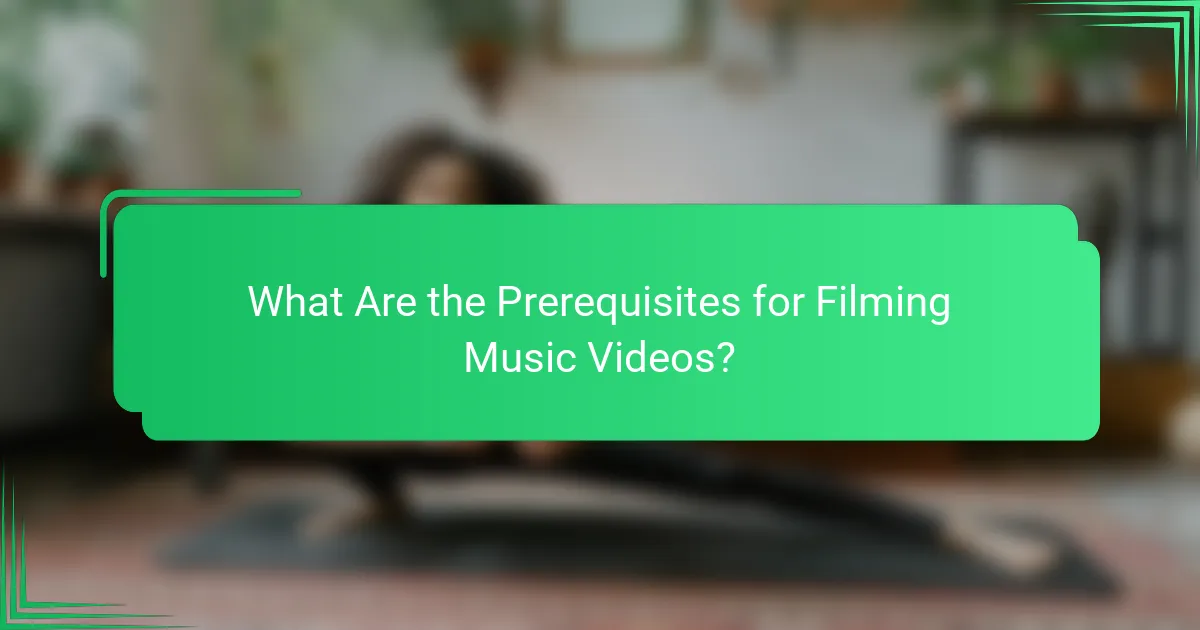Creating engaging music videos on a budget is entirely feasible with the right techniques and creativity. By utilizing accessible tools and resources, you can produce visually appealing content that captivates viewers and enhances storytelling. Focus on innovative concepts and dynamic camera angles to elevate your production while staying within your financial means.

How Can You Create Engaging Music Videos on a Budget?
Creating engaging music videos on a budget is entirely feasible with the right techniques and creativity. By utilizing accessible tools and resources, you can produce visually appealing content without breaking the bank.
Utilize smartphone cameras
Smartphone cameras have advanced significantly, often rivaling professional equipment. Most modern smartphones can shoot in high definition, making them ideal for capturing quality footage without the cost of expensive cameras.
When using a smartphone, consider stabilizing your shots with a tripod or gimbal to avoid shaky footage. Experiment with different angles and settings to maximize the visual appeal of your video.
Incorporate DIY props
DIY props can add a unique touch to your music video while keeping costs low. Simple materials like cardboard, fabric, and paint can be transformed into eye-catching elements that enhance your visuals.
Think creatively about everyday items that can serve as props. For example, using colored lights or reflective surfaces can create interesting effects without requiring professional-grade equipment.
Leverage natural lighting
Natural lighting is a cost-effective way to enhance the quality of your music video. Shooting during the golden hour—shortly after sunrise or before sunset—provides soft, flattering light that can elevate your visuals.
Avoid harsh midday sun, which can create unflattering shadows. Instead, find shaded areas or shoot indoors near windows for a more controlled lighting environment.
Use free editing software
There are several free editing software options available that can help you polish your music video without incurring additional costs. Programs like DaVinci Resolve, HitFilm Express, and Lightworks offer robust features suitable for various editing needs.
Familiarize yourself with the software through online tutorials to maximize its potential. Focus on key editing techniques such as cutting, color correction, and adding effects to enhance your final product.
Collaborate with local artists
Collaborating with local artists can enrich your music video while sharing resources and talents. Reach out to aspiring filmmakers, dancers, or visual artists who may be interested in working together on a project.
Such collaborations can lead to creative synergies, allowing you to pool skills and equipment. This not only reduces costs but also expands your network within the local creative community.

What Techniques Enhance Music Video Engagement?
Engaging music videos captivate viewers by utilizing creative techniques that enhance storytelling and interaction. Effective methods include visual storytelling, audience participation, and dynamic camera angles, all of which can be executed on a budget.
Storytelling through visuals
Visual storytelling is essential for creating an emotional connection with the audience. By using imagery that complements the song’s lyrics and mood, you can convey a narrative that resonates with viewers. Consider using a simple plot or theme that aligns with the song’s message to keep the audience engaged.
To implement this technique, think about the key moments in the song and how visuals can illustrate those emotions. For example, if the song speaks about love, scenes depicting intimate moments or shared experiences can enhance the narrative. Aim for a clear beginning, middle, and end to guide viewers through the story.
Incorporating audience interaction
Engaging the audience directly can significantly boost viewer interest. Techniques such as call-to-action prompts or interactive elements like polls or challenges encourage viewers to participate actively. This can be as simple as asking viewers to share their interpretations or experiences related to the song.
Consider leveraging social media platforms to create a dialogue around the music video. For instance, you might encourage fans to submit their own clips or reactions, which can be featured in future videos. This not only fosters community but also increases the video’s reach and engagement.
Using dynamic camera angles
Dynamic camera angles can transform a standard music video into a visually stimulating experience. Experimenting with different perspectives, such as close-ups, wide shots, or aerial views, can add depth and excitement to the visuals. This technique helps maintain viewer interest throughout the video.
When planning your shots, think about how each angle can enhance the story or emotion of the song. For example, a close-up during a powerful vocal moment can emphasize the artist’s expression, while a wide shot can showcase the energy of a crowd. Keep in mind that smooth transitions between angles are crucial for maintaining flow and coherence.

Which Creative Ideas Can Make Your Music Videos Stand Out?
To make your music videos stand out, focus on innovative concepts that resonate with your audience. Creative ideas can elevate your production without requiring a large budget, allowing you to express your artistic vision effectively.
Theme-based concepts
Choosing a strong theme can unify your music video and enhance its emotional impact. Consider concepts that reflect the song’s message or the artist’s persona, such as nostalgia, empowerment, or love. For example, a retro theme could incorporate vintage clothing and settings, while a nature theme might feature outdoor scenes that evoke tranquility.
When developing a theme, ensure it aligns with your target audience’s interests. Engaging storytelling elements can create a deeper connection, making the video memorable. Avoid overly complex themes that may confuse viewers; simplicity often resonates best.
Unique location choices
Selecting unconventional locations can add visual interest and originality to your music video. Instead of typical studio settings, consider shooting in local parks, urban environments, or even abandoned buildings. Each location can convey a different mood and enhance the narrative of your song.
Research potential locations for accessibility and permissions. Some sites may require permits, while others might be free to use. Always have a backup plan in case of unexpected weather or logistical challenges, ensuring your shoot can proceed smoothly.
Incorporating animation
Animation can bring a unique flair to your music video, allowing for creative storytelling that live-action may not achieve. Techniques like motion graphics or 2D animation can illustrate themes or lyrics, making the video visually engaging. Consider collaborating with local animators who can work within your budget.
When integrating animation, ensure it complements the live-action footage rather than overwhelming it. A balanced mix can enhance the overall aesthetic and keep viewers captivated. Keep animations concise and relevant to maintain the viewer’s focus on the music and message.

What Are the Prerequisites for Filming Music Videos?
Filming music videos requires careful planning and preparation to ensure a successful production. Key prerequisites include developing a solid script and storyboard, scouting appropriate locations, and assembling the right equipment.
Script and storyboard development
Creating a script and storyboard is essential for visualizing the music video. The script outlines the narrative or concept, while the storyboard provides a frame-by-frame guide to the shots and scenes. This process helps streamline filming and ensures that all creative ideas are captured effectively.
Consider collaborating with a director or a creative team to brainstorm ideas that align with the song’s themes. A well-structured storyboard can save time during shooting and minimize the need for extensive reshoots.
Location scouting
Location scouting involves finding suitable settings that enhance the video’s aesthetic and narrative. Look for locations that resonate with the song’s mood and lyrics, whether it’s an urban environment, a natural landscape, or an indoor space. Local regulations may require permits for filming in public areas, so check with local authorities.
When scouting, take note of lighting conditions, accessibility, and potential background noise. Consider visiting locations at different times of day to assess how natural light affects the scene.
Equipment checklist
Having the right equipment is crucial for achieving high-quality visuals and sound. A basic checklist includes a camera, tripod, lighting gear, microphones, and props. Depending on your budget, you can rent equipment or use smartphones with good camera capabilities.
Ensure that you have backup batteries, memory cards, and any necessary cables. If you’re working with a small crew, assign specific roles to streamline the filming process, such as a director, camera operator, and sound technician.

How Do You Measure the Success of Your Music Videos?
Success for music videos can be gauged through various metrics, including views, engagement rates, and audience retention. Understanding these factors helps artists and producers refine their strategies for future projects.
Views and Engagement Metrics
Views are the most straightforward indicator of a music video’s reach. However, engagement metrics such as likes, shares, and comments provide deeper insights into how well the content resonates with the audience. A video with high views but low engagement may indicate that while it attracted attention, it failed to connect meaningfully.
To analyze engagement effectively, consider tracking the like-to-view ratio and the number of comments relative to views. A good benchmark is a like-to-view ratio of around 5-10%, which suggests that viewers are not just watching but also appreciating the content.
Audience Retention Rates
Audience retention rates reveal how long viewers stay engaged with the video. A high retention rate indicates that the content is captivating, while a sharp drop-off at a specific point may highlight areas needing improvement. Aim for a retention rate of at least 50% for the first half of the video to ensure that the audience remains interested.
Tools like YouTube Analytics can help track these metrics, providing insights into which parts of the video keep viewers engaged and which parts may need reworking in future projects.
Feedback and Comments
Feedback from viewers can be invaluable in assessing the success of a music video. Analyzing comments can reveal audience sentiments and preferences, offering direct insights into what worked and what didn’t. Encourage viewers to leave feedback by asking specific questions in the video or description.
Consider creating a simple survey linked in the video description to gather structured feedback. This can help you understand viewer preferences and guide future creative decisions.


